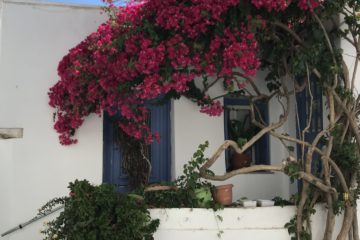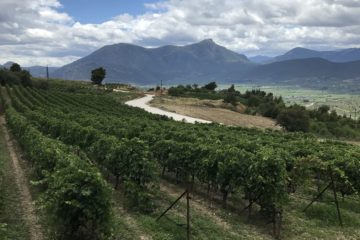Since long before our trip, Rorie had been talking about “this one town in Vietnam where you can get custom tailored suits for really cheap,” and it was finally time to get there – Hoi An, Vietnam. Rorie had planned and budgeted to spend some real money on getting a new business wardrobe while there, and I became intrigued by it as he talked more about it and researched it. [Editor’s note: It had become an almost mythical place in my mind and my eagerness to use this opportunity to fortify my work wardrobe led me to create a separate line item in my budget just to buy tailored items. Well worth it.] Between the time it would take (several days, which is insanely fast for suits but a good amount of time to spend in one place) and the fact that we knew we’d need to ship a box of stuff back to America, I felt that it was an easy opportunity for me to experiment with custom tailoring for the first time. I had never really considered custom clothing before, but this was basically a free pass to shop and get whatever I wanted, right? [Editor’s note: My theory is that when Jess heard the amount I was planning to spend on suits in Hoi An, she 1) took it as a challenge to spend as much on whatever items she could think of and 2) as an opportunity to shop with impunity without fear of me scolding or browbeating her. I went in with a plan. She just went in and went crazy. But really, are we surprised by this?]
We got off an overnight bus from Da Lat tired but ready to see what this town was all about. As a first sign of good things to come, our hotel was beautiful and one of the nicest places we’ve stayed on our entire trip by far (with a real, separate shower instead of the wet baths we’ve come to expect!). [Editor’s note: It cost a whopping $18 per night. Vietnam is the best. Also, I can’t emphasize enough the broad spectrum in the quality of bathrooms/showers we’ve experienced on this trip. We’ll never take them for granted again!] The weather was also warmer than in Da Lat (since we were back down at sea level), so these factors energized us to shake off the fatigue of the overnight bus to head out to evaluate some tailors and get the process started.
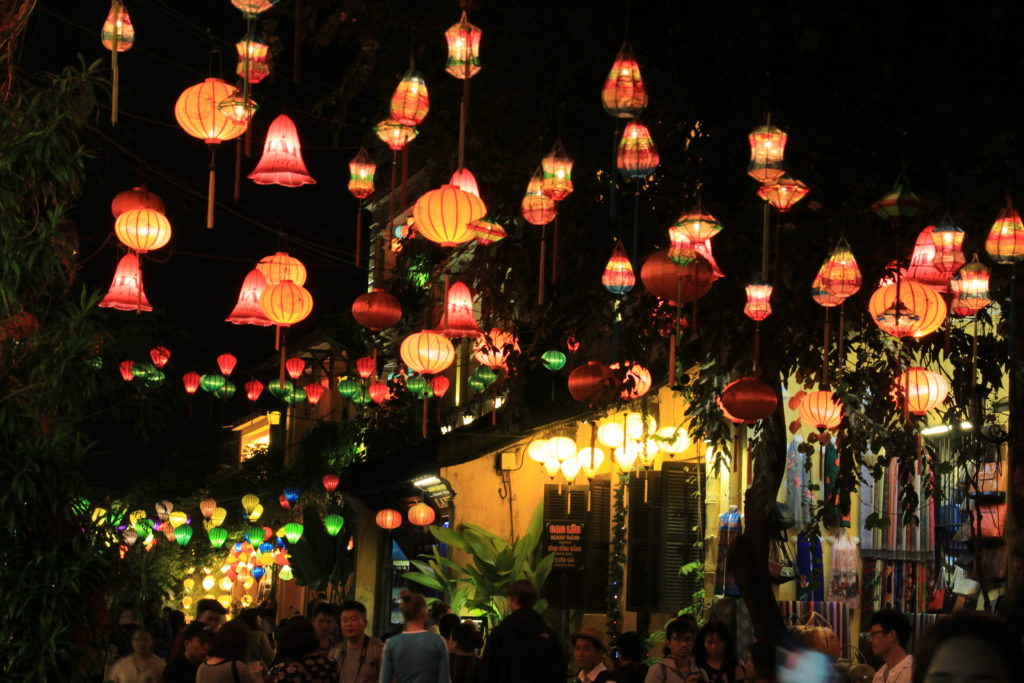
The lantern-lit old city at night
Custom Tailoring in Hoi An
We both read lots of blog articles about tailoring in Hoi An, so we ended up undertaking a combination of what we learned and what we figured out along the way. First, we both thought about what we might want to have made and took screenshots on our phone of images to show the tailors. For Rorie, this meant mostly researching the intricacies of suit-making, and images of things like lapel widths and pant lengths. [Editor’s note: I literally reached the end of the internet when it comes to articles about custom suit making, with most of the information proving to be useless. Basically, I went overboard with my neuroses and researched too much for no good reason. Not uncommon for me at all.…] For me it was a little more general – I saved photos of dresses and blazers I liked, along with some images of pants I kind of wanted, with the vague idea that maybe the tailor could help me come up with the right combination of ideas. We also took notes on names of specific tailors anytime we came across mentions of them in blog posts, and then looked up reviews of the on TripAdvisor and pinned them on Google Maps.
This all may sound like overkill (and probably was), but it led us to a narrowed-down list of about 8-10 shops we were considering (yes I know, that was the “narrowed-down list”) out of the ~700 different tailoring shops in Hoi An, all of which were within about 5 minutes walking of each other on the main strip of town. Paring down the list was necessary because basically every storefront has mannequins outside displaying sample items and walls full of fabrics lining the entire inside of the shop. Some shops specialize in certain types of clothes, like gowns, coats or swimsuits, and some do a little of everything. Some are fancier, with clean big tiled showrooms with air conditioning and fancy signs outside, while some are just small openings on the concrete sidewalk, crowded with fabric piles and a lightbulb swinging from the ceiling. I think it would be quite overwhelming to walk in without a plan, so I felt better knowing that we had a list and background knowledge. [Editor’s note: We had also heard stories about people getting scammed into expensive prices, crappy craftsmanship or cheap materials, so it was worth doing research to ensure we didn’t fall prey to those types of issues. Also, people would literally drive up on motorbikes, hop off and try to convince us to go into their shops. It was kinda ridiculous.]
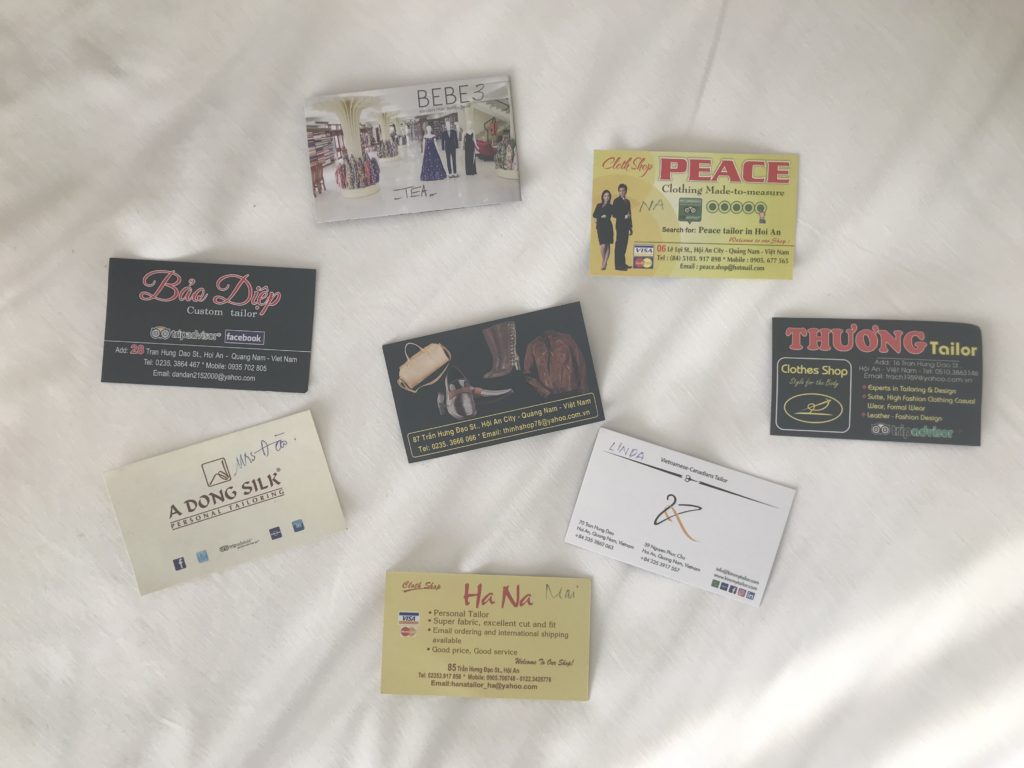
These are *some* of the business cards we collected from every place we went into and/or bought from.
We spent several hours that first day just walking into most of the shops on our list, talking to the employees (almost always women), having them show us fabric selections and tell us rough prices. The pricing varied considerably depending on how nice the shop was, but we’d read consistently that you get what you pay for so we planned on going to higher-end shops for nicer items such as suits and blazers. We hadn’t planned to actually place any orders that first day, but after talking to 6 or 7 different shops, we felt like we had a good sense of where we wanted to go. Some of the shops had great reviews but just didn’t give off a good vibe in person, or the salesperson we spoke to didn’t seem interested in what we really wanted, just in making a sale. In a few cases, Rorie felt like the employees didn’t know much about suits or different fabrics, which was a major red flag. Based on all of this, Rorie decided to get 4 suits from A Dong, one of the nicer spots in town, and a bunch of more casual button-down shirts from Tulip, a much smaller and more casual shop. I selected Kimmy’s Tailor for the bulk of my nicer work items like blazers (also a higher-end spot), and Ha Na tailor for some work-appropriate dresses because I loved their example designs and saw almost exactly what I had in mind.
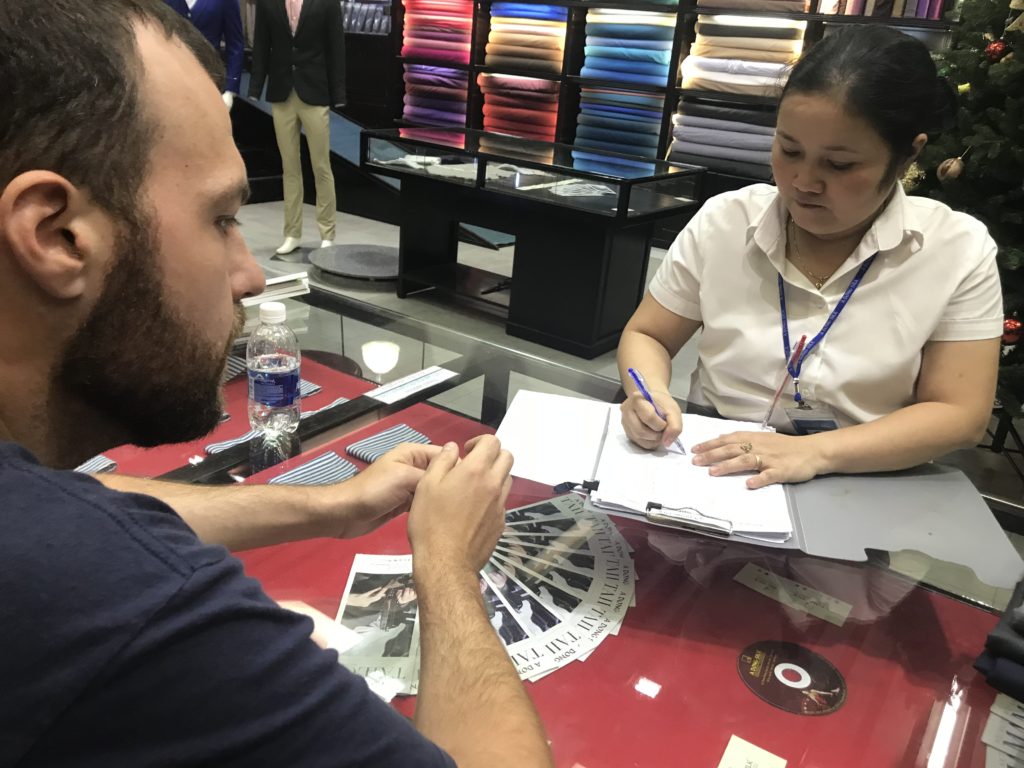
Rorie discusses suit ideas with his tailor.
The process for all of these spots was similar. You walk in and are immediately approached by a salesperson/tailor who “adopts” you for the entire process. In the higher-end places, they have iPads with image libraries already loaded on like a catalog, or you can show images you have on your phone or just walk around and point to example items around the shop. For more complicated items like blazers or suits, our tailors sketched out drawings of what we wanted right in front of us to make sure we were getting details like pockets and buttons correct, but for simpler items it was just a conversation. Once the item in question is established, it’s time to pick the different fabrics for the piece. This was the fun part, since I loved walking around and thumbing through piles or walls of fabric rolls and feeling like I could really customize what I wanted. After fabrics are selected you need to finalize the price, which was tough for me as I didn’t necessarily want to commit to a certain item before knowing the final price. It made for a slightly uncomfortable situation as I felt the tailors had a lot of leverage after going through the design and fabric design process. We were able to haggle though, so in the end I feel like I did an okay job of getting good prices. The haggling was not nearly as drastic as in the local markets – often the final price would only be 10-15% lower than the original quoted price if you could get it to move at all, which I had read about and was prepared for. [Editor’s note: It made a huge difference in our ability to haggle if we were getting multiple items or buying expensive items (e.g., the original quote on my suits was $825, but I was able to haggle them down to $660). Another effective technique was to haggle the price down as far as possible, then to ask them to toss in some free stuff as well to cinch the deal – this is how I got the suit place to toss in a couple of silk ties and my leather bag place to include a leather belt.]
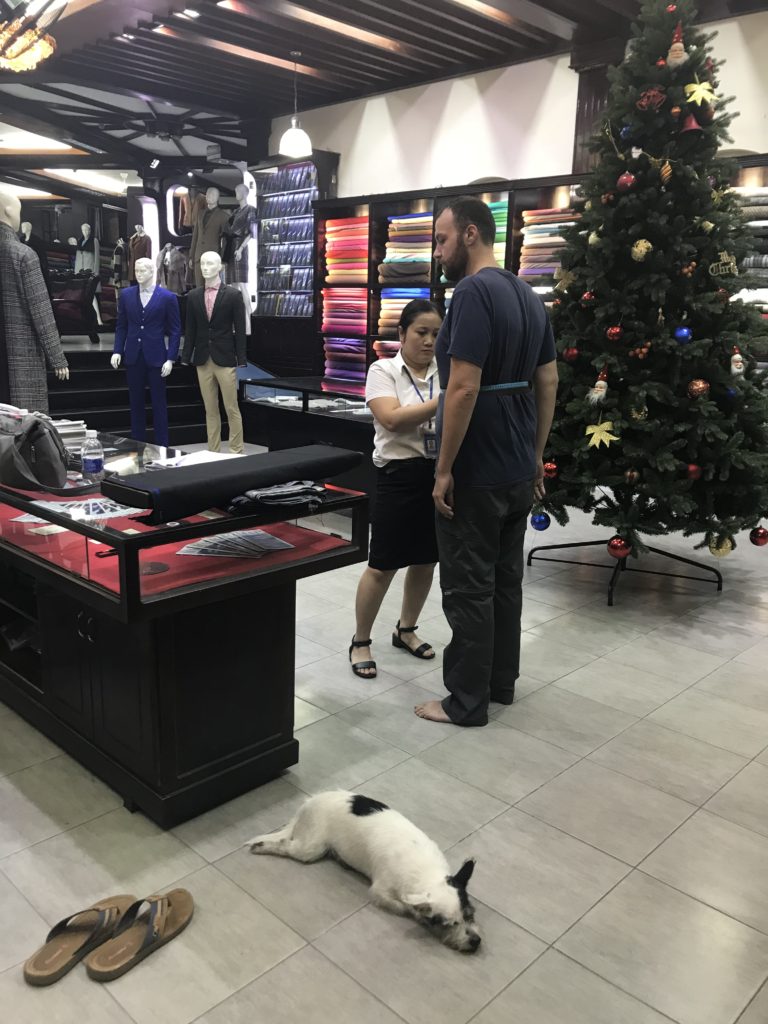
Rorie gets measured while the shop dog hangs out at A Dong.
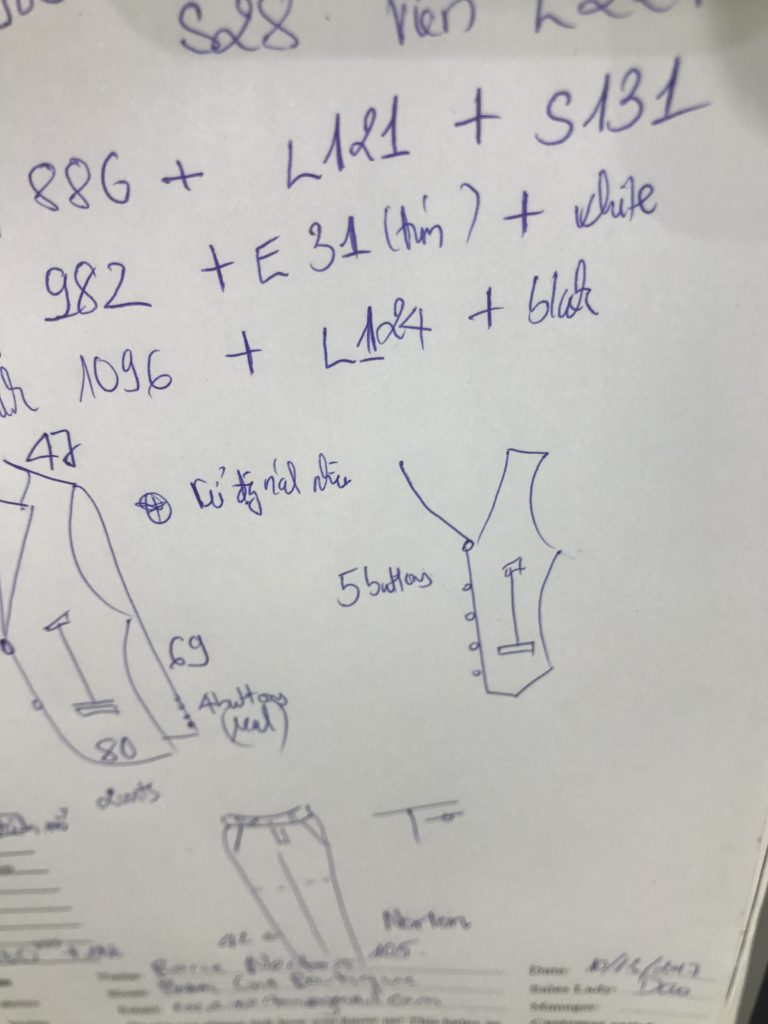
Some of the notes and measurements about Rorie’s suits
After all of that you get to the actual measurements, where they quickly and professionally measure every conceivable direction and angle on your body. I imagine this is the most important part of the whole process, since it’s made to custom fit your body, but it was ironically also the fastest part of the process since dumb tourists like us don’t have opinions about it – our measurements are what they are (unfortunately, in some cases)! The last step is to put down a deposit (anywhere from 30-50% of the final item price) and decide when to come back for your first fitting, which was often within a day and sometimes just later in the same evening. I have no idea how they work so fast, honestly. At the fittings, it really varied how much adjustment was needed based on the intricacy of the item and the skill of the tailors. For complex items like suits and blazers, they would just grab chalk and pins, start ripping seams, marking up the fabric, and pinning it while you wear it in front of a mirror. For other items like the more casual dresses I got, the fit of the items was more forgiving and they got it really close on the first try (which is amazing, frankly), so we only had small notes for them. For one pair of pants, I wanted a bit of a custom design with elastic around the ankles that my tailor was not convinced about; in fact, she repeatedly tried to convince me to do a more traditional pant style as we discussed it. I had to carefully explain what I was going for several times, and it took three fittings, but I felt vindicated when she looked at the finished product on me and said “oh, I might have to make myself a pair like these!”
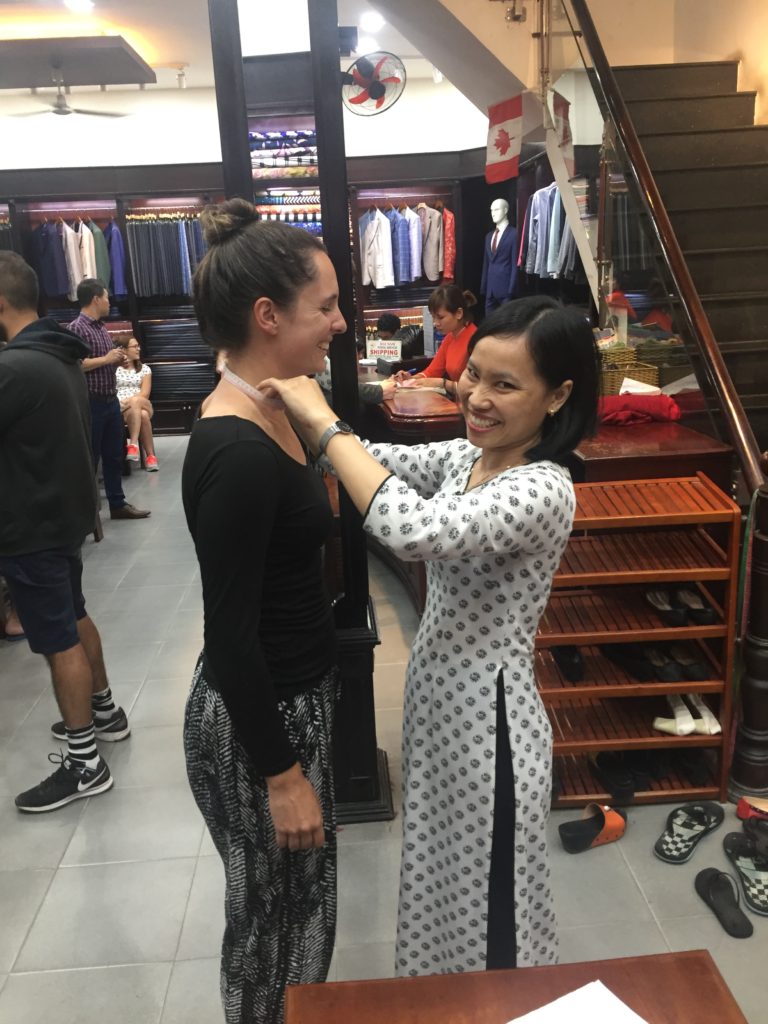
Getting measured by Linda, my wonderful tailor at Kimmy’s
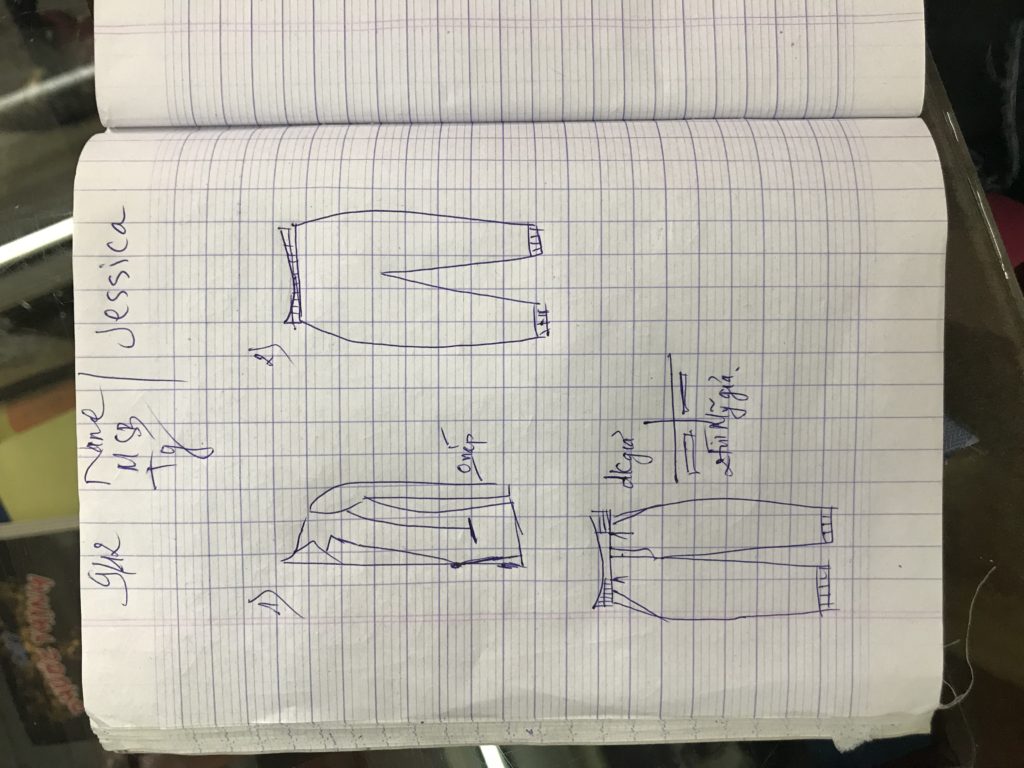
Some of Linda’s sketches of the pants we designed for me
The process was really fun and novel at first, and we had such a good time with our first few fittings that we decided to expand our custom clothing wardrobe past what we’d originally planned. We saw a store with nice winter coats outside and ended up each getting one made for our future winters (and yes, I’m aware we are moving to Texas, but it snowed there last week, okay guys?!). I also thought that custom clothing would be a good chance to try items where I could never find the right fit in stores. For me, this included rompers, so I decided to try one and loved it so much after the first fitting that I ordered another one on the spot. Adding to my unexpected purchases list, I found a place doing custom swimsuits and decided to get one! Who ever thought about custom swimsuits? Certainly not me, but I’d been wanting another one for our trip, and I had an idea of what I wanted but so far have not come close to fitting into the Vietnamese-sized suits I’d seen in stores so I figured why not? “Why not” turned out to be a wonderful and dangerous attitude in Hoi An, as every store suddenly seemed full of possibility. [Editor’s note: Jess was only limited in what she could buy by the scope of her imagination. I learned in Hoi An that she’s way more creative than I had given her credit.…]
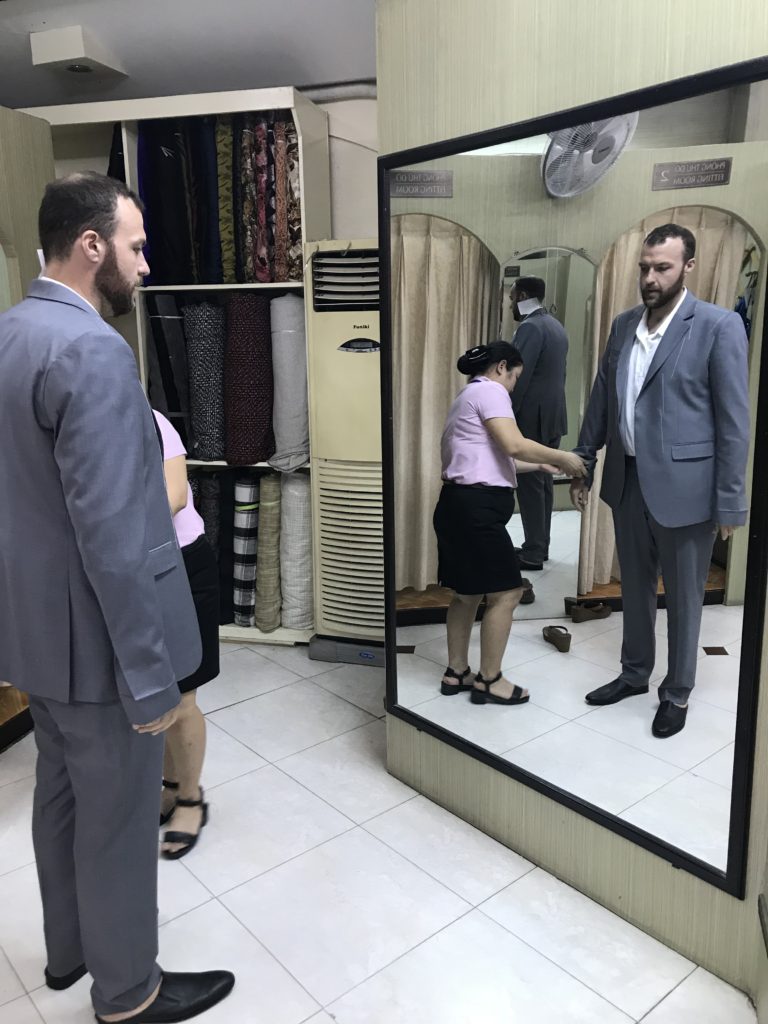
Rorie at his first suit fitting. Note the chalk lines and dress shirt that is 4 sizes too big and the slip-on dress shoes he borrowed for it, since we didn’t have anything in our packs that would work.
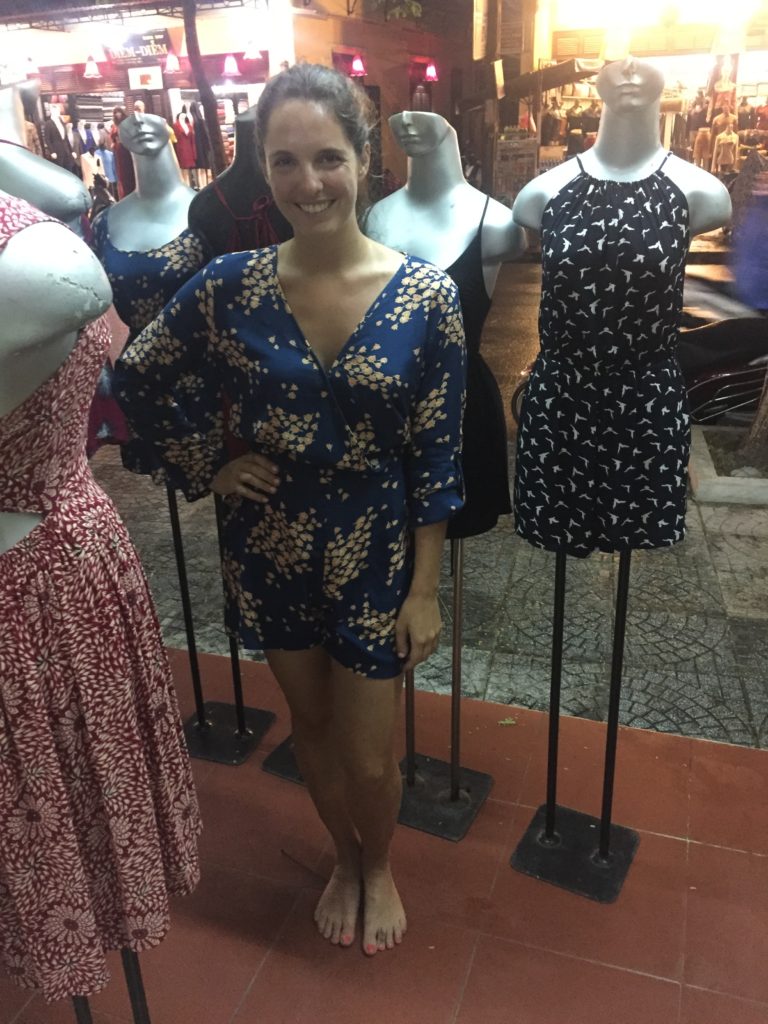
My custom designed romper, less than 24 hours after deciding that I wanted one.
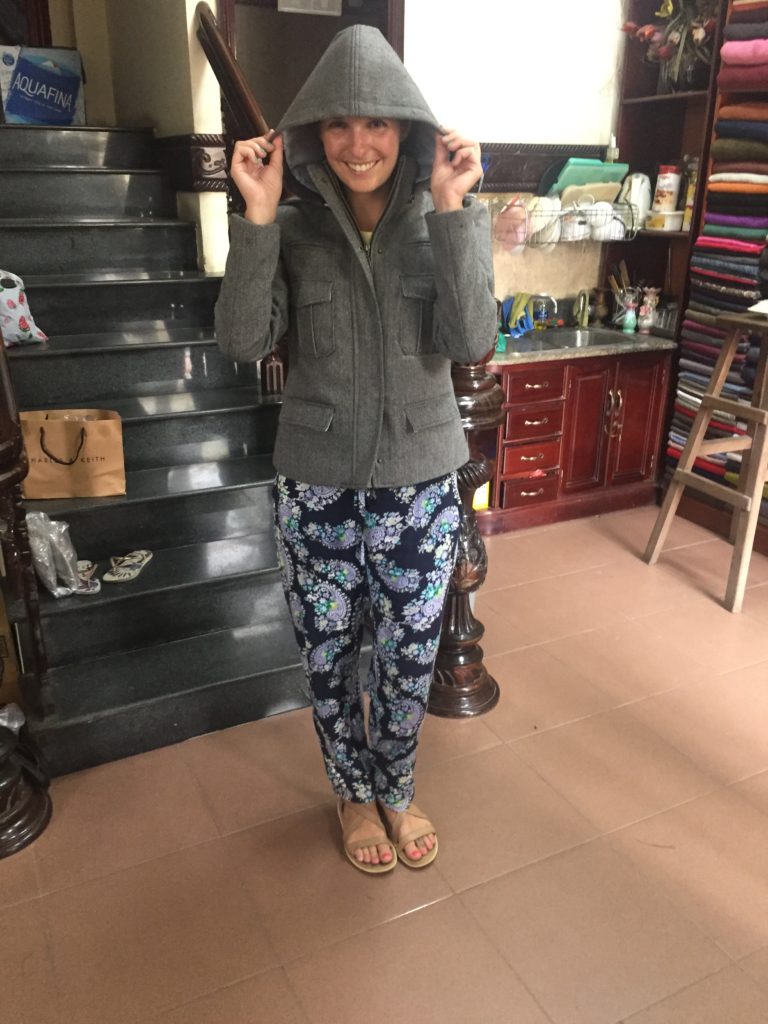
Modeling the hood on my new winter coat
For all our items, we tried our best to keep a few things in mind when deciding whether or not it was really worth it. The rules I tried (with varying success) to hold myself to were approximately the following:
Is <X> item worth getting made here in Hoi An?
- Is it an item where custom fit and tailoring really makes a difference? (e.g., suits or highly tailored blazers or dresses)
- Is it an item that is really hard to find in stores with the correct fit for my body? (e.g., rompers for me, and button-down shirts for Rorie)
- Is it something where getting to pick out the fabric will make a big difference to me? (e.g., a cotton maxi dress and a pair of casual shorts in fun, unexpected prints)
- Is it something that is a good value here compared to what I can buy it for back home? (e.g., Rorie’s leather bag cost $95, but comparable bags go for $250-300 at home).
As long as an item fell into one or more of these categories for me, I felt okay going for it. Did we buy too much? Almost definitely! Was it fun? Absolutely. In the end, we spent around 5 days in Hoi An and ended up with a ton of stuff (weighing approximately 45 lbs total) to ship home (embarrassingly, it was too much to fit into a single box due to American shipping size limits, so we needed to ship in two boxes; sorry Mom and Dad!). It’s hard to know if the stuff will all end up as regular parts of our wardrobes once we settle back into our lives, but I like to think it will.
In case anyone is curious, here’s a mostly-complete list of what we got and what we ended up paying (all prices are in U.S. dollars):
- 4 suits (3 two-piece suits, 1 three-piece suit, and 2 ties) – $660 [Editor’s note: To give you a sense, this was only a little bit more than what it cost for me to get just one two-piece suit custom made in NYC a few years ago using super cheap fabric, rather than the beautiful (and extremely expensive) fabrics I selected for these four suits.]
- 2 blazer jackets & 2 pairs of tailored pants – $265
- 3 nice work dresses – $120
- 9 casual button-down men’s shirts – $170
- 2 cotton rompers – $20 each
- 2 winter coats – $100 total
- Leather boots – $45
- Leather duffel bag & leather belt – $95
- Casual maxi dress – $20
- Shorts – $19
- Bikini – $28
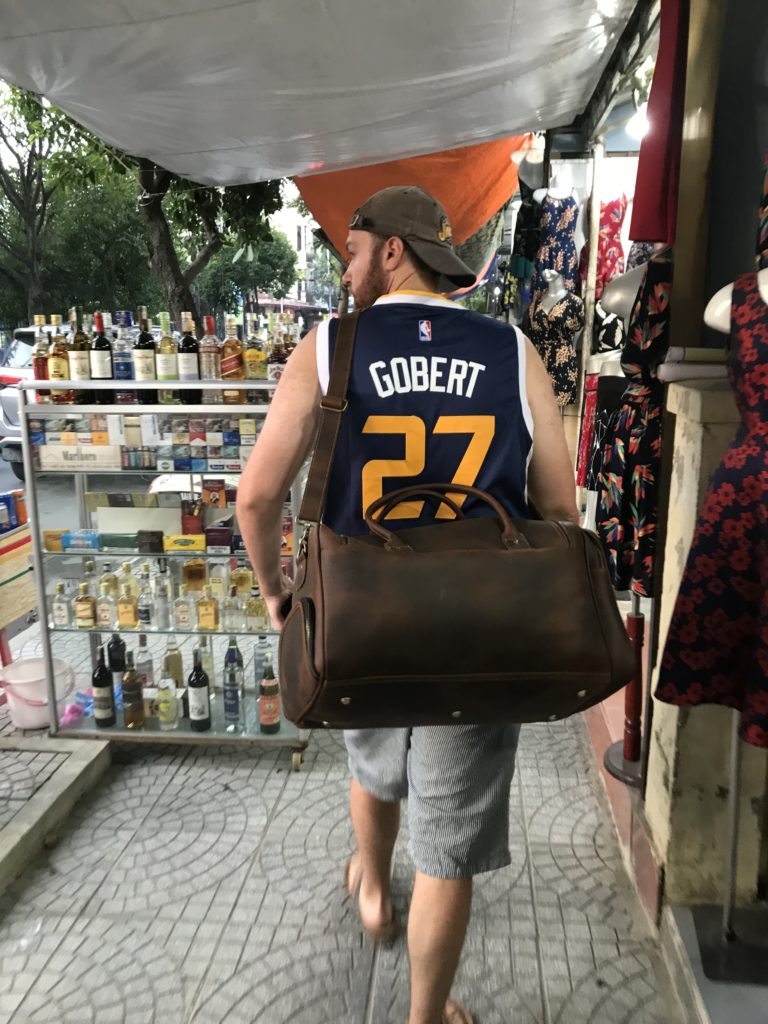
Rorie with his new leather duffel (and knock-off Utah Jazz jersey, of course)
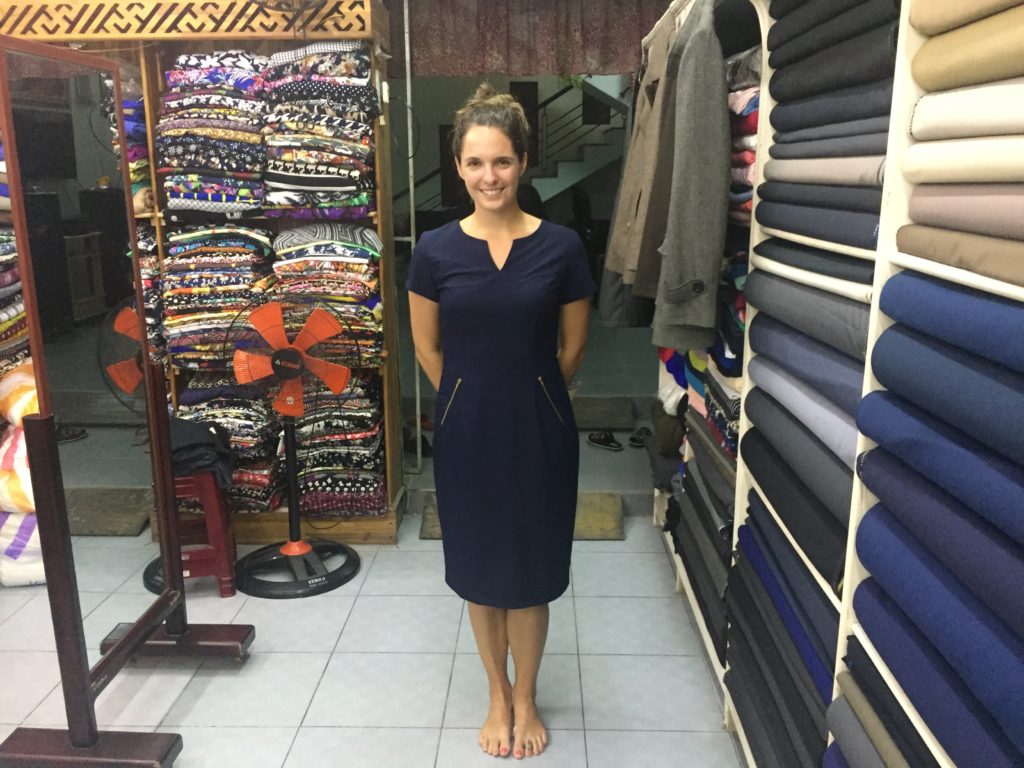
Tailored dress for the office (when, you know, I have an office)

Rorie in one of his 9 new button-down shirts with his very happy tailor
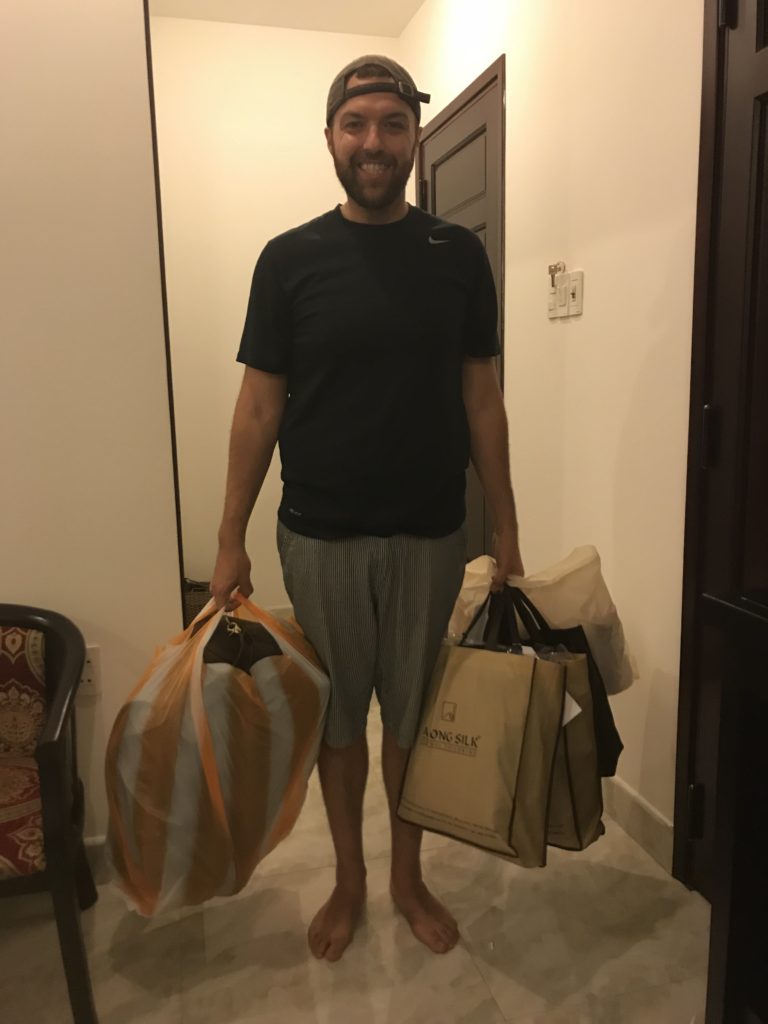
Oops, we kind of bought a lot
What else is in Hoi An besides tailoring?
The old quarter of Hoi An, which is pretty much the entire town from what I could tell, is a UNESCO World Heritage Site. It has adorable cobblestone streets lined with French architecture and a lovely riverside walkway with rows of restaurants and bars on both sides. Every night, the entire waterfront area is illuminated with hundreds of beautiful paper lanterns hanging over the streets, from every storefront, and along the water. Boats float the river giving tourists rides back and forth, and old women sell paper lanterns with candles that you can put into the river while making a wish. It’s all very walkable and very charming, and we wandered the strip every night, trying a new restaurant or bar each time and taking in the sights.
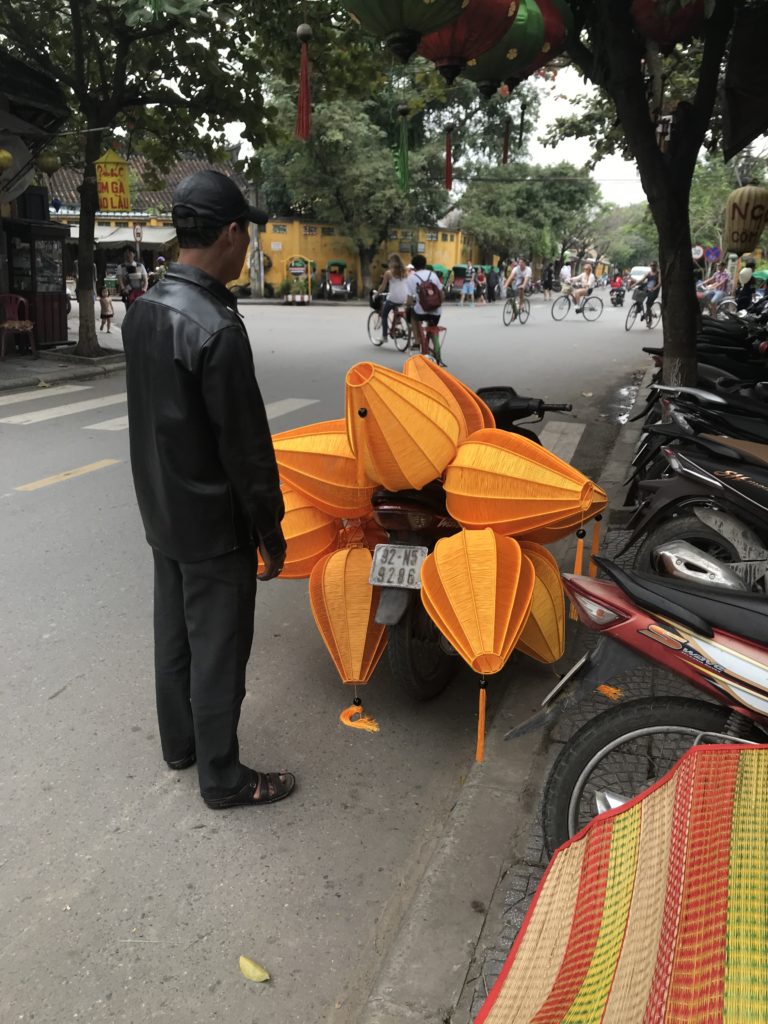
Contemplating how to add more paper lanterns to the back of a motorbike
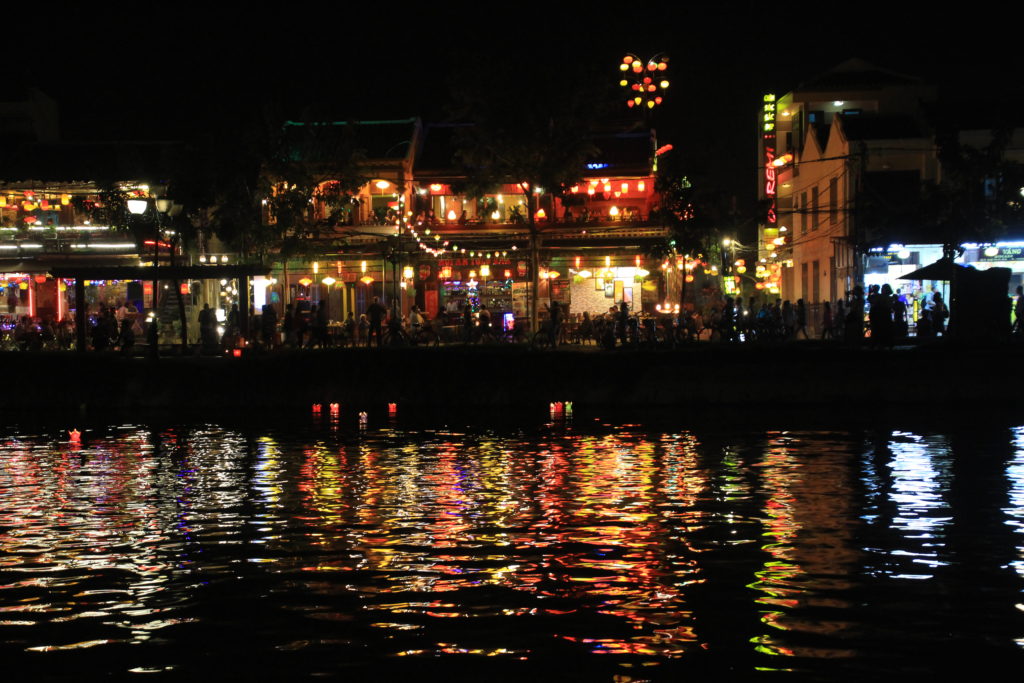
Looking across the river
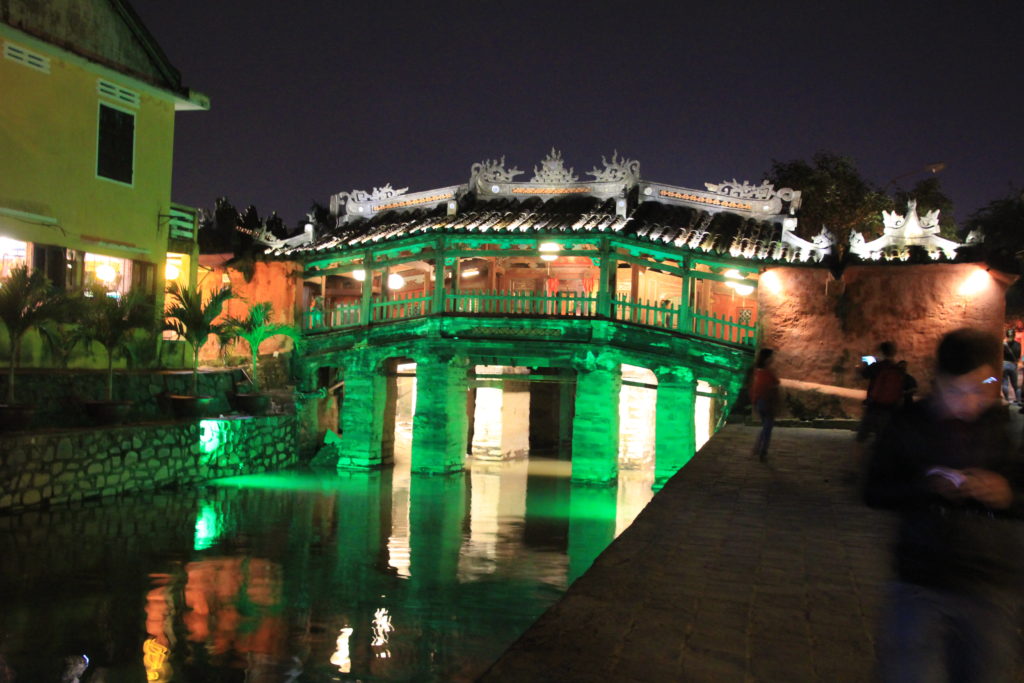
The famous “Japanese Bridge” in the old town
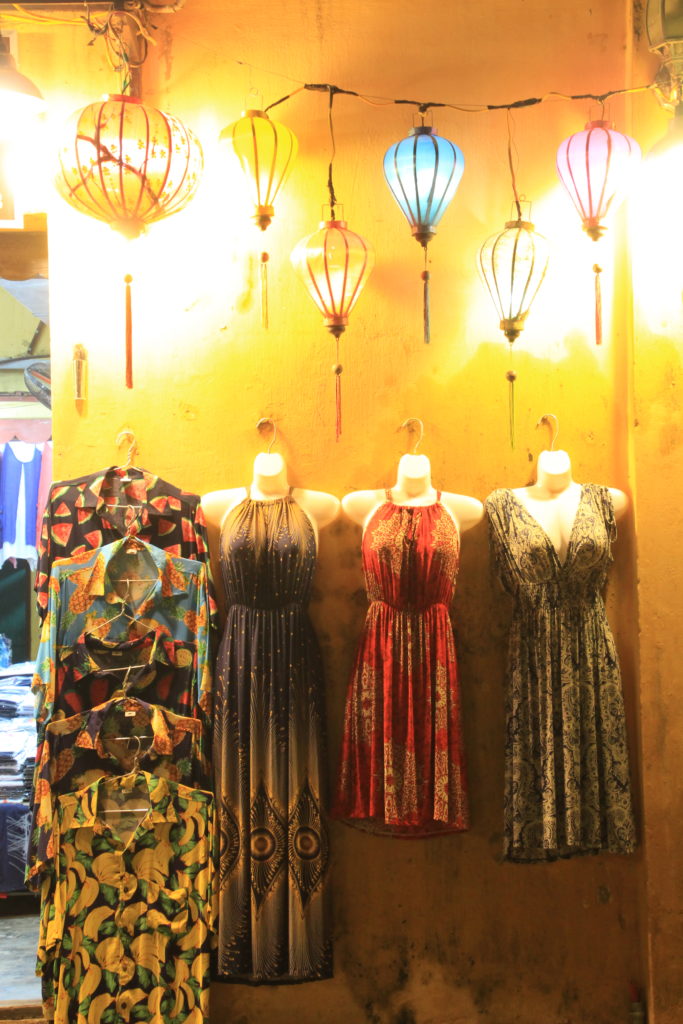
A tailor shop at night
Between our fitting appointments during the day and wandering the waterfront at night, we had plenty to do to enjoy the city. It was relaxing and easy to hang out, and I can definitely see why everyone we met raved about it. We will also become those travelers evangelizing the city to others we meet along the way as we go. [Editor’s note: Totally agreed. Hoi An is a fantastic city on its own, but the affordability of the clothes should catapult it up the list of places where people swing through while in Asia in order to stock up on clothes before going on to their next destination. You can save thousands of dollars and it’s totally worth it.] Next up, we reluctantly said goodbye to Hoi An and continued making our way north to Hue (and tried to see some sights along the way, with mixed success).
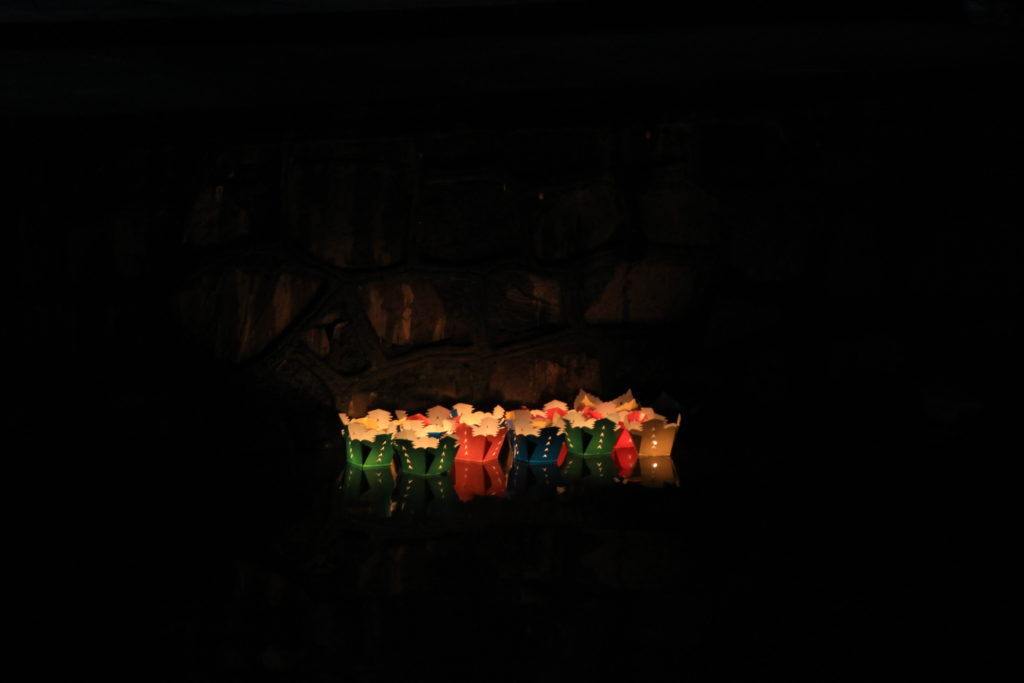
Candles in paper lanterns float down the river
